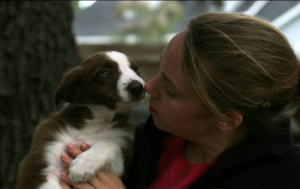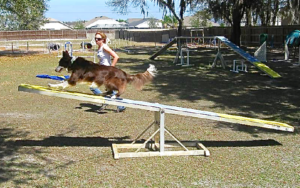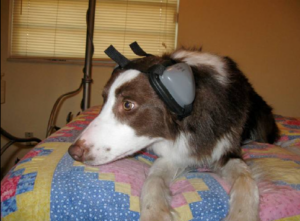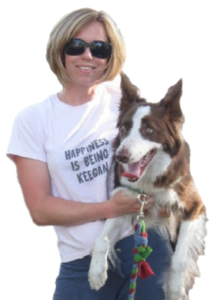Barks Blog
Behavior Modification — A Case Study of a “Difficult” Dog
By Maren Jensen Ph.D. and Angelica Steinker M.Ed. CDBC PDBC PCBC-A
The Joy and Journey of Rehabilitating a Dog with Obsessive Compulsive Disorder, Panic Disorder, Pica, Separation Anxiety, Noise Sensitivity and Aggression

Rumble was a normal puppy. He investigated, pounced and loved all. Rum, as he is affectionately known, socialized with confidence and happiness, starting at nine weeks. He learned how to learn playing games. Maren, his owner, is a dog trainer and dog sport coach. Everything seemed on track for Rum to make a spectacular entrance into the dog sport world…
Six Months
Sexual maturity can be the onset for genetic mental illness in dogs, although the data on this is unclear because of early spaying and neutering. At six months Rum began showing stress when puppies approached him, but his love of people continued. During a routine nail trim, Rum attempted to bite Maren in the face. Previous nail trimmings had been done with food and many small approximations. There was no history that could explain this sudden shift in behavior. As is appropriate with most aggression, Maren remained calm and did not move away — Maren wanted to avoid Rum learning that aggression works (please not that only a professional should take this kind of a chance as there is risk of being bitten with this strategy). Another problem appeared at Rumble’s third vet visit when he showed stress during handling. During previous visits he had been very happy.
Soon Rum was biting Maren when she was handling him and his feet. Maren was bitten numerous times on her arms and legs. Most bites were nips, but occasionally he used his full mouth. Avoiding triggers of biting would have been ideal, but new sensitivities were cropping up quickly, making it impossible for us to anticipate all triggers.
Within a month of the aggressive nail trimming event, Rumble’s issues generalized to include other dogs, including dogs he had grown up with. His aggression during nail trimming and vet visits escalated. Maren temporarily stopped trimming his nails. Soon any handling of Rum became a source of stress. Touching any part of his body triggered displacement behaviors and Maren’s cuddly affectionate puppy could not be touched.
When modifying aggression, is important to teach a dog to relax, this is done with slow, calm petting or massage. In Rumble’s current state, this was impossible. Maren began a very rough scratching type of massage on his face and then gradually built up to his head and neck. This was the only touch that Rum enjoyed. After months of massaging, she was able to touch Rumble all over again and this quickly generalized to all familiar people.
Sensory Integration Disorder
In humans there is a new disorder that is being called sensory integration disorder. Children affected by this disorder show touch sensitivity, have high pain tolerance and
they may be unable to respond to certain sensory information. This leads to an inability to plan and organize sensory information and what needs to be done in an appropriate and automatic manner which in turn may cause fright, flight and fight or withdrawal responses. Rum had high pain tolerance, fight and withdrawal responses. Playing at home, he would slam hard into the walls and never flinch or yelp. Doing agility he would fall off of obstacles and never bat an eye, even when he was visibly injured. Rum shattered one of his puppy canine teeth, requiring the vet to pull numerous pieces out from within the gum line, but Rum was still tugging like a maniac and eating. It seemed that he did not process the feeling of pain normally. Treatments for sensory integration disorder are similar to dog agility training, in addition Maren added balance exercises intended to help integrate senses.
Athleticism
Parenting a dog with multiple mental health issues is particularly challenging when he is born to run all day. Compounding this, Rumble was unable to leave his house at his peak of mental illness. Maren resorted to exercising him in her backyard and after hours — months of rehab at the empty dog school. At home, Rumble started fence-fighting with the neighbor’s dogs. Maren immediately added a second row of fencing that created a buffer, preventing the problem. The damage was already done, Rumble would lose focus and frequently became unable to learn if he could hear the neighbor’s dogs bark.
At the empty dog school Rumble’s speed and agility were awesome, but performing in front of strange people or other dogs was impossible. Yet Maren continued to be dedicated to his agility training since it was building his confidence, and giving him much needed mental and physical stimulation. As part of his agility training, Rum learned the teeter.

Teeter
Rumble learned all of the equipment very quickly and negotiated it all at top speed, except for the teeter. Initial training of the teeter had gone smoothly, but then suddenly Rumble balked at performing the full height teeter. Maren, knowing, the importance of foundation training, restarted the teeter training. Once the teeter was lowered to a nearly flat position, Rumble immediately and enthusiastically did the teeter again. To get him accustomed to the noise we spent hours banging the teeter while Rumble and Maren played. Rumble confidently performed a mini-teeter and a lowered training teeter.
For the second time, very gradually Maren began raising the full-height teeter. Rumble was happy and confident but once it reached full height he again began to refuse the teeter. For the third time, retraining the teeter began. Again, Rumble progressed quickly and was soon doing the teeter full height. Success! Or so we thought, until one day when Rumble fell off the dog walk. For reasons we cannot explain, the fall off the dog walk caused him to immediately refuse the teeter. Close to giving up, Maren again retrained the teeter, for a fourth and final time. Today he performs the teeter with such extreme confidence and speed that it is hard to imagine there was ever an issue.
One explanation Rum’s teeter problems is his panic disorder, a genetic illness which causes the victim to have severe anxiety attacks. Both in humans and animals, panic attacks can be associated with locations or objects. This association can lead to avoidance of that location or object. We assume that in Rum’s case, a panic attack may have accidentally been linked with the teeter. Another possibility is that the movement, noise and negotiation of this obstacle triggered his sensory integration problems.
Catching the Wave
Another thing about Rum is that his mental ability to learn or perform a behavior can be similar to waves in an ocean. If you ask Rum to perform a cue he may or may not be able to do it based on where the wave is. The cue has to be timed in a way that you can catch the wave. Usually when an animal balks at an obstacle you go back to a much easier step in the training, quickly refreshing the dog’s memory. We noticed with Rum that his hesitations were not based on missed steps or repetitions in the training process but rather on some sort of internal wave dynamic. With time and patience this “phase” of Rumble’s learning seems to subside.

Fireworks
The first time Rum heard fireworks, he was five months old and he showed no response. When he heard them again at 10 months of age, Rumble showed extreme stress, shaking and panting and once the fear was triggered there was no calming. The vet prescribed some anti-anxiety medications which appeared to have no effect, but a pair of Mutt Muffs. Originally designed to help reduce cockpit noise, this product has Velcro straps which fasten around the dog’s head. Dogs can still hear fireworks or thunderstorms, but the sound is greatly reduced and most noise sensitive dogs experience less anxiety. The Mutt Muffs reduce Rum’s fear from a 100 to a 20 on a scale of 100 being complete panic and 0 being no fear.
Pica
As an adolescent Border Collie, when his anxiety disorders peaked, Rum started obsessively chewing. Here is a list of some of the things Rum chewed:
- His own tail hair
- Family room blinds
- Video camera
- Books, toilet paper
- Prescription bottle with pain killers
- Shoes
- DVDs
- Couch
- Couch cover
- Coffee table, kitchen table and chairs
- Rugs
- Plastic hamper
- Neosporin
- Clothing
- Hats
- Camera
- Bed sheets, pillows, blankets, towels, wash cloths
- Agility ribbons
- Silverware
- Cell phone
Dr. Karen Overall VMD Ph.D. determined that Rum has virtual separation anxiety. Every time Maren turned her back on Rum he would anticipate her departure and grab an item to ingest. Usually the items were things that Maren had just handled and placed out of his reach. Many times items were grabbed within a few seconds of Maren briefly turning her back. A bottle of pain killers was grabbed within three seconds of Maren touching it. Maren’s vet had to induce vomiting and Rum threw up all of the pills, a mascara label, pieces of his toy and part of a towel. All if this had been ingested as Maren was getting ready for work and had never left the room Rum was in.
“Ceiling Fans Implicated in Death of Several Border Collies”
This is what the headline reads on Rumble’s news channel ticker. At 18 months of age Rum suddenly dis- covered the ceiling fans in the house. We mention his age because 14 to 18 months can be another onset period for genetic mental illness. Both sexual maturity (six months of age) and the later social maturity time period can act as genetic light switches for behavior to suddenly appear.
One would assume that a moving ceiling fan may be scary and that still fan would be ignored. Not with Rumble! He became fearful of the ceiling fans if they were turned off. Fans that are spinning are fine, but fans that are not spinning apparently can be deadly. Maren was forced to leave the fans on at all times because Rum would panic if he saw a still fan. We can’t know but it is possible that Rum had a panic attack while looking at a still fan. The panic became associated with the still fan and, “bam!” a massive fear was born. Maren continues to manage the problem by keeping the fans turned on.
Impulse Control
Starting with the first bite, it was clear that Rum had difficulties controlling his impulses. Humans who have impulse control disorders (ICD) are prone to aggression, hair pulling, self-mutilation, gambling and substance abuse. Rum’s impulse control most closely resembled the human intermittent explosive disorder. A simple explanation of this disorder is to call it road rage. One second Rum seemed fine, and the next second he would explode. After the rage subsided he was completely normal. The switch had been flipped back and he was focused and ready to learn. If Rum saw another dog or became frustrated he would redirect his aggression to whoever was closest. On several occasions he redirected on Maren or one of his housemate dogs.
In humans, ICD can include self-mutilation and hair pulling and as an adolescent, Rum pulled and ate his own hair. Fortunately, this subsided with Prozac and amitriptyline which also prompted other improvements. It took some detective work to figure out if Rum was doing the hair chewing. The “cuts” to his hair were so straight it looked as if it was mechanically cut. However, Maren placed some food dye on the hair and sure enough the dye showed up on Rum’s lips.
Global Suppression of Behavior
One of the most challenging issues with Rum was his absolutely stoic facial expression and body language. After his friendly puppyhood body language faded we thought we were dealing with a dog that just wasn’t very expressive. Prior to realizing the extent of his issues, it was impossible to tell if Rum was stressed or not stressed.
We very much wanted to keep him unstressed, but always seemed fine. Then seconds later he would blow his fuse. Could it be that he was suddenly stressed coming to the same location he had been coming to since he was a pup?
Rum’s stoic body language was actually a result of his severe anxiety. He was so anxious that he had become globally suppressed. Global suppression of behavior is usually a by-product of punishment. Dogs fearing punishment stop displaying behavior and withdraw into their shells. Socializing Rum had pushed him into global suppression of behavior.
Flooding is when a being is overwhelmed with fear. Rum, who was never subjected to punishment training, learned to go numb because of accidental flooding.
Back to Kindergarten
Rum was globally suppressed, so we had to find WHERE Rum was happy and then gradually increase his world from there. Turns out he was happy at home.
For one month Rum stayed home, so that he could start to feel safe. Then began the tedious process of gradually shaping Rum to leave the house. First, clicking and treating for simply looking out the open front door, then planting cookies outside so that Rum could step out onto the front door mat and find a treat. This training continued for months until Rum could hop into the car and be happy. Gradually building up to longer time periods in the car, Rum ate dinner in the car and played games in the car. Three months later, Rum arrived at the school, a different dog. Joyous and happy he clobbered Angelica with love. The puppy Rumble was back.
Counting
Rum will always suffer from some level of anxiety, so instead of focusing on competitive dog sports, he learned to count. Using flash cards and golf balls, Rum indicates 0–4. He has also learned:
- How to perform a handstand against a wall
- Balancing on his exercise ball
- Targeting (lifting) each of his four feet on cue
- Trimming his own nails – Rum scratches at a board that is covered with an abrasive surface that files his nails
- Crawl
- Roll over
- Hide his face with his paw on the cue “shy”
- Standing on back feet and moving back and forth
- Heeling – he will knock your socks off with his fabulous extremely accurate heeling
Conclusion

Today Rum enjoys being physically touched by people he is familiar with. Today he can perform agility while unfamiliar people watch, and has run at his first competition. The work of acclimatizing him to other dogs and unfamiliar people continues. While Maren and Rumble’s journey continues, Maren says this about why she loves Rum: “Even thinking about writing this, I get teary-eyed. At this point I can’t imagine my life without Rum and I think most ‘normal’ people couldn’t imagine their lives with a dog like Rum. A good friend of mine asked me when Rum was less than a year old if I regretted getting him. I couldn’t give her a straight answer.
“Do I regret having a dog with issues? On some level I’d love a ‘normal’ dog, sure, who wouldn’t? But the real question is, do I regret having Rum in my life and that’s a big fat NO. I love him more than words can express, but that’s just a cliché, many people feel that way about their dogs. I don’t doubt than many peoples’ dogs are very special to them. Rum is special on so many other levels. I truly think there are very few dogs out there like him. With the problems that he has suffered through and the range of emotions that he feels, I don’t think it’s fair and there is a lot of pity and sympathy I have for him.
“Loving Rum is something like loving someone who needs you more than they need air to breathe. I don’t know how else to express it. It’s such a mutual experience. I love Rumble for the way that he looks at me and searches for me when he first wakes up from a nap. He needs that reassurance that I’ll never leave him. I love Rumble because he has taught me more than I thought possible about animal behavior and emotions. I love Rumble because I don’t have any other choice. That sounds like an ultimatum but it’s the best decision I’ve made in a long time, to love him each day. Love means that I can forgive him for chewing up most items in my house. Love means I forgive him for beating up on the other dogs occasionally and even beating up on me. Loving Rumble was one of the hardest things I’ve done in my life.
“At this point, no one could pay enough money or make an offer good enough for me to regret taking Rum into my life. I got him as a potential agility competitor. He plays agility beautifully, one of the best I’ve en, but he may never get to compete again because of his issues. It’s taken me a LONG time to accept that and I’ve shed many tears realizing the actuality of our situation. Loving Rumble means that I accept him for who he is and I don’t try to change him, just make him happy in his own skin.”
Accomplishing the Impossible
Throughout the years of writing this article Rumble has accomplished some major feats. At the age of three and a half, Maren could trim Rumble’s nails without being bitten. Maren has trained Rum to give kisses instead of bite. Kissing is an incom- patible behavior to biting. It has been many months since Rum has tried to bite during a nail trim.
Rum’s second major accomplishment is that he successfully competed in numer- ous agility competitions. His first competition was in October of 2009 Rum earned two of three qualifying runs! Within seven months of competition, Rum earned five Novice agility titles, one Open title and was just one run away from an Elite Weavers title. Rumble excels at agility and even competed in new environments with very little stress evident. Agility is a great outlet for his anxiety and he is very good at it. Maren only runs Rum at one ring trials and with four assistants, one person stationed at each side of the ring.
Rumble’s recent major feat is accepting a new dog; Bliss is an Australian Shepherd, into his home. Rum can be left free with Bliss and he does not show any aggressive behav- iors, as a matter of fact he has a new best friend. At bedtime, Rum and Bliss are in the bed next to each other ready for a good night sleep!
Note: Pet owners should always seek the advice of a qualified behavior consultant if their dog behaves aggressively. Getting professional help at the first sign of aggression is the best course of action. Thank you to Leslie McDevitt’s outstanding Control Unleashed program.
This article was first published in the June 2012 issue of BARKS from the Guild.
Sign up today for you free lifetime digital subscription to BARKS!
About the Authors
Angelica Steinker M.Ed. CDBC PDBC PCBC-A owns and operates Courteous Canine, Inc. DogSmith of Tampa, a full service pet business and dog school specializing in aggression and dog sports. She is the national director of training for DogSmith Services, and co-founder of DogNostics Career College.
Maren T. Jensen PhD CAP1 earned her BS in Biology from the University of North Florida. from 1997-2000 and graduated with a Bachelor’s of Science degree in Biology. She earned her doctorate in Biology from the University of South Florida, specializing in neuroscience.
